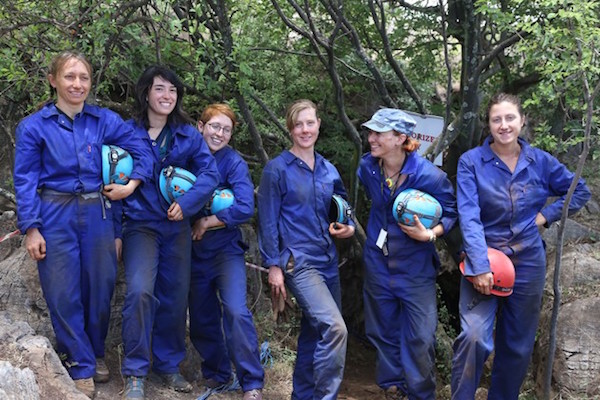Lee Berger led a team of trowel-blazing scientists behind one of the richest collections of hominin fossils ever discovered
Lee Berger put his ad up on Facebook on October 7th, 2013. He needed diggers for an exciting expedition. They had to have experience in palaeontology or archaeology, and they had to be willing to drop everything and fly to South Africa within the month. “The catch is this—the person must be skinny and preferably small,” he wrote. “They must not be claustrophobic, they must be fit, they should have some caving experience, climbing experience would be a bonus.”“I thought maybe there were three or four people in the world who would fit that criteria,” Berger recalls.
“Within a few days, I had 60 applicants, all qualified. I picked six.” They were all women and all skinny—fortunately so, given what happened next. Berger, a palaeoanthropologist at the University of the Witwatersrand, sent them into the Rising Star Cave, and asked them to squeeze themselves through a long vertical chute, which narrowed to a gap just 18 centimeters wide.
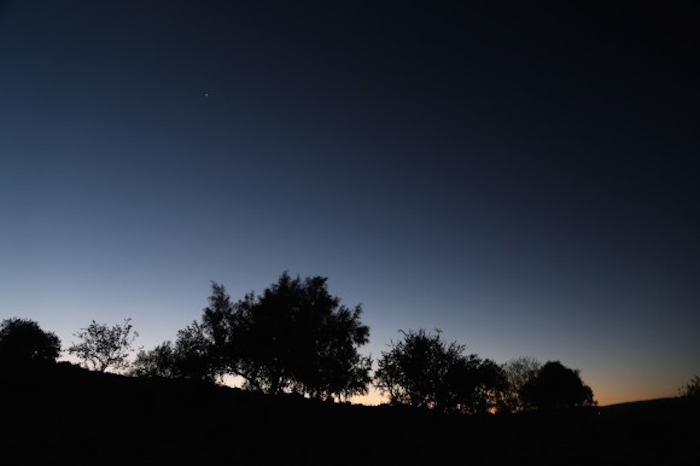
Venus over the camp at Rising Star Cave, South Africa. Photo: Courtesy of Hannah Morris.
That gap was all that separated them from the bones of a new species of ancient human, or hominin, which the team named Homo naledi after a local word for “star.” We don’t know when it lived, or how it was related to us. But we do know that it was a creature with a baffling mosaic of features, some of which were remarkably similar to modern humans, and others of which were more ape-like in character.
This we know because the six women who entered the cave excavated one of the richest collections of hominin fossils ever discovered—some 1,550 fossil fragments, belonging to at least 15 individual skeletons. To find one complete skeleton of a new hominin would be hitting the paleoanthropological jackpot. To find 15, and perhaps more, is like nuking the jackpot from orbit.
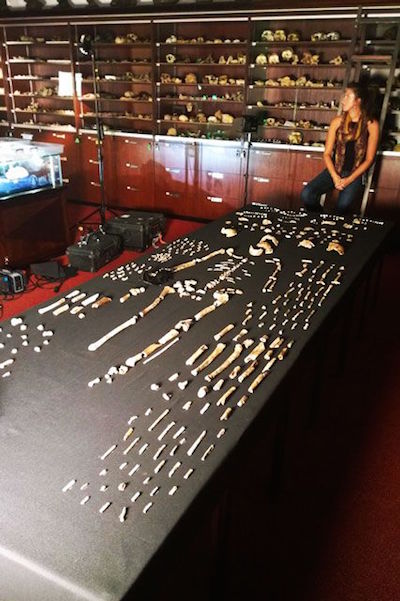
Bones from the Homo Naledi discovered in the Rising Star cave in South Africa. Photo: Courtesy of Hannah Morris.
The early hominins included the australopiths, with their sturdy builds, long arms, short legs, and small brains. A couple of million years ago, they were joined by the first members of our genus Homo, with their longer legs, stiffer walking feet, more dextrous fingers, and much larger brains. And some curious species harbor traits that are typical of both lineages.
In 2008, Berger found one such mosaic in South Africa’s Malapa cave: a new hominin called Australopithecus sediba. He spent the next five years studying it. The project became so all-encompassing that in 2013, Berger, an explorer at heart, realized that he had stopped exploring. To rectify that, he enlisted two cavers, Rick Hunter and Steve Tucker, to explore other South African caves that might yield important fossils. The Rising Star Cave was one of them.
When the duo entered it in October 2013, they weren’t expecting much. Cavers had thoroughly explored the system for some 50 years, and the chances of finding anything new were low. Tucker did so by accident. During a rest, he wedged himself in a crevice—and found that his feet didn’t touch the bottom. The crevice, it turned out, led to an absurdly narrow shaft, which descended for 12 meters before opening into a chamber. When Tucker dropped into it, he found bones. He took out his Go-Pro and snapped some shots.
When Berger saw the pictures, he was amazed. He was clearly looking at the skull and jawbone of a hominin, maybe an Australopithecus. “That evening, I couldn’t sleep,” he says. At 2 in the morning, he called Terry Garcia, the National Geographic Society’s chief science and exploration officer, who had funded Berger’s digs before. “If you ever believe in me, believe in me now,” Berger said. “Terry said: Do whatever you need to do.”
Berger quickly rounded up a team of scientists—and six skinny cavers. Marina Elliott was the first and oldest of them on the scene. When she first saw Berger’s ad, she was finishing off a Ph.D. at Simon Fraser University and had already done a lot of fieldwork in Siberia and Alaska. “I was predisposed to extreme environments,” she says. “Telling me that I’d have to do climbing, that it would be underground, and that it would be strange and potentially dangerous… it appealed.” She was joined by five others: Elen Feuerriegel from Australia, and Americans K. Lindsay Eaves, Alia Gurtov, Hannah Morris, and Becca Peixotto.
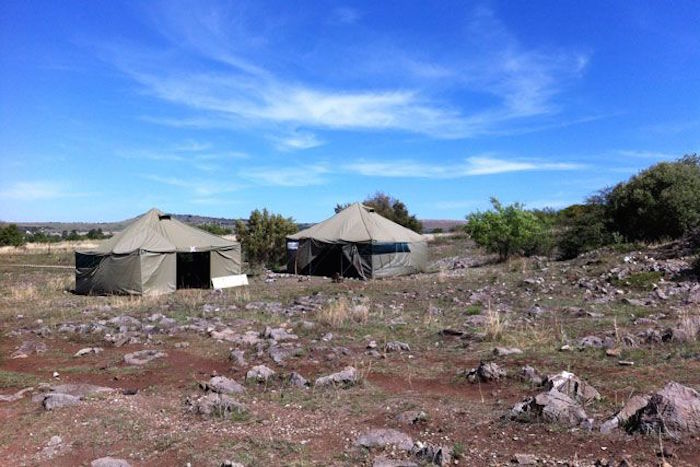
The team’s campground near Rising Star Cave, in South Africa. Photo: Courtesy of Hannah Morris.
By November 7th, a month after Berger’s ad went up, a 60-person camp had assembled next to the Rising Star Cave. Three days later, the team ventured inside. “We knew the fossils were going to be super-important. They clearly weren’t human,” says John Hawks from the University of Wisconsin–Madison, whom Berger recruited. “We thought we were going to excavate one skeleton. Because what else would you find?”
After entering the cave, the team almost immediately hit several narrow, pitch-black corridors, a knife-edge ridge called the Dragon’s Back with steep drops on either side, and finally that 12-meter chute. “It’s a long crack, punctuated by shark-teeth protrusions,” says Elliott. “I remember looking down and thinking: I’m not sure I made the right decision.”
Once you get to the very bottom of the shoot, there’s a very small opening. I actually fit my chest in that opening and inflated my lungs; as I exhaled, I could lower myself inch by inch to the floor of the fossil chamber, which is about a four meter drop. So my legs are dangling in the air, and I’m sliding down inch by inch, trying to find a foothold on the cave wall or on the ladder that’s below me.
It’s very physical. It’s very intense, both physically and mentally. You need a lot of physical strength and mental endurance to go all of that way and then spend six hours in an underground chamber.” –Hannah Morris
At the bottom, the team eased down into an area they dubbed the Landing Zone, before entering the fossil-filled trove that they called the 101 Chamber. On the first day, they excavated a single bone—a mandible. “It came out and we said: Wait a minute, this isn’t what we thought,” says Hawks. Tucker’s images hinted at an australopith-like jaw but he had forgotten to include a scale bar. The actual specimen was vastly smaller, and its teeth were almost human-sized. “We thought: We’re looking at something special here.”
On day two, they settled into a rhythm. The six cavers went underground in six-hour shifts, working in claustrophobic darkness and often on all fours. The most challenging part “was the emotional intensity of recovering the fossils themselves,” says Elliott. “There was so much material and it was friable and delicate. And every day, we realized that we were pulling out another 40 or 60 fragments of this thing that was going to be incredible.” Back on the surface other scientists started preparing and cataloging the fragments. As they unwrapped the packages, “we realized that we had been wrong,” says Berger. “It wasn’t a skeleton. It was more than one.”
NOVA/National Geographic Video: footage of scientists exploring the cave.
By the end of the week, the team had excavated more fossils than had ever been found in a South African site. Shortly thereafter, they exceeded the tally from all of southern Africa from the previous 90 years. It took months to process all the 1,550 or so fragments and assemble them into 15 skeletons—male and female, elderly and infant. As hominin fossils go, that’s a superlative haul, paralleled only by Spain’s Sima de los Huesos cave, a bonanza of Neanderthal remains.
These types of multiple individual sites are rare and important for looking at variation, which is after all the thing that evolution works from,” says Susan Antón from New York University, who was not involved in the project. Some other hominins are known only from the most measly of specimens, like small pieces of jaw or finger. “You’re always used to taking a single scrap and working it to death,” says Hawks. “If we only had one piece of Homo naledi, we wouldn’t know anything like the picture we have.”
That picture is evocative but confusing. It shows a slender, upright hominin, which stood between 4.5 and 5 feet tall. It had relatively long legs and very human-like feet, which probably made it a good long-distance walker—a trait that Berger describes as “the defining characteristic of the genus Homo.” Then again, its hip bone was flared in a australopith-like way, and its thigh bones had ridges that were unlike any found on other hominins.
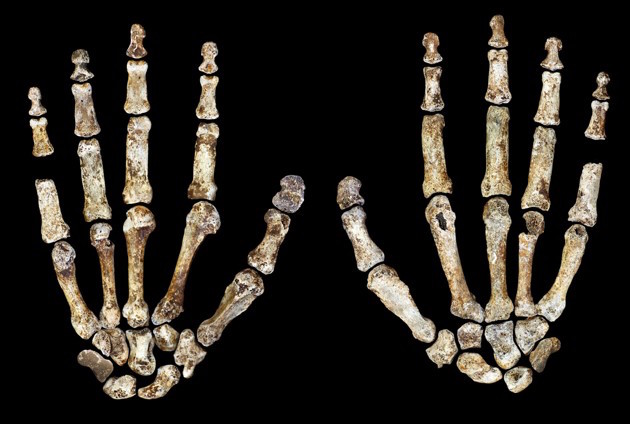
Bones from the Homo Naledi discovered in the Rising Star Cave in South Africa. Photo: Peter Schmid
Its arms are similarly confusing. The shoulders are almost ape-like, but the hands “are more human-like than any other fossil hand, except for Neanderthals,” says Hawks. However, Its fingers are incredibly curved and its first thumb bone had unique ridges for the muscles that draw it close to the hand. This was a creature with a very powerful grip. “I don’t know what to make of that,” says Berger. “They’re climbing, but I don’t know what they’re climbing.
And then there’s the skull. As I talk to Berger over Skype, he picks one up from his desk. It neatly fits in his hand, as though someone had shrunk the skull of Homo erectus down to the size of Australopithecus.“By the second morning, we were asking ourselves: What are we looking at here?” says Hawks. The team quickly discounted the idea that they had found several species, since the various copies of any single bone were all the same. Every femur looked like every other femur. H.naledi was clearly a single creature, albeit one with a confusing mish-mash of features.
“Everything was just all over the place,” says Berger, whose earlier discovery, A.sediba, also married features from both Australopithecus and Homo. “We were one of the better teams in the world to make this discovery. The idea of mosaicism was drilled into our heads,” says Berger.
It’s tempting to suggest that both species—A.sediba and H.naledi—were intermediate steps on straight evolutionary climb from Australopithecus to ourselves. But these are no “missing links.” Both may be mosaics, but they’re different mosaics. Each has different sets of australopith-like and human-like traits that can’t be easily reconciled on the same family tree.It’s especially difficult to do so because the team still haven’t dated the specimens—a fact that has vexed several other paleoanthropologists.
Listen to the BBC The Conversation Interview with scientists Elen Feuerriegel and Jill Heinerth
“I am puzzled by the apparent lack of attempts to estimate its age,” wrote Chris Stringer from the Natural History Museum in London, in a related commentary.“If these fossils were three million years old they would tell us something totally different than if they were thirty thousand years old,” adds Carol Ward from the University of Missouri. “Without dates, the fossils reveal almost nothing about hominin evolution, beyond supporting the growing realization that there was much more species diversity than previously thought.”
Hawks is less concerned. “They could be the ancestors of humans. They could be some sort of really primitive creature that lived alongside modern humans,” he says. “To not be able to tell which of those is the case is pretty engaging.”And their behavior might have been similarly engaging. “We have very strong reason to suspect that H.naledi was doing culturally interesting things, and was doing it with a small brain,” Hawks adds. What kinds of things? “Well, like depositing their bodies in a cave.”
How did all those bodies get in a chamber that is 70 metres from the outside world and many metres down an impossibly tiny crevice?
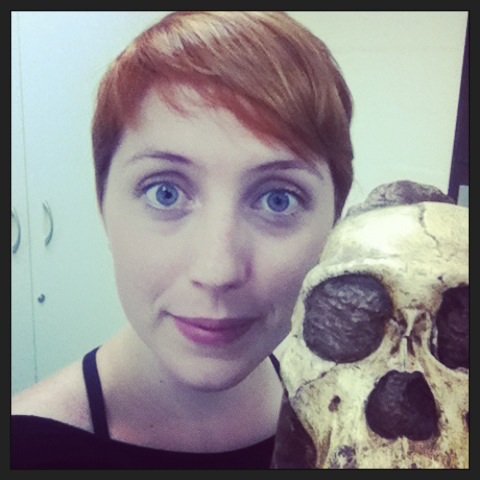
Elen Feuerriegel, one of the tiny cave women scientists who answered Lee Berger’s ad, posing with one of the skulls discovered in Rising Star Cave.
On the 1,550 pieces of bone, the team couldn’t find a single mark made by a tooth or a stone tool, or any trace of a fracture that happened when the individuals were still alive. “These were the healthiest dead things ever seen,” says Berger. That ruled out cannibals, prehistoric serial killers, or predators that dragged them down into the crevice. The sediment in the chamber also revealed no evidence that water had carried the bodies in from outside. There’s no debris to suggest that the individuals were actually living in the cave. And most tellingly of all, except for a few bones from a bird and some rodents, H.naledi is the only thing in that chamber. “We found nothing else, and the only time you ever find just one thing is when humans deliberately do it,” says Berger.
Perhaps they took their dead to the cave and dropped them in from the top of the chute. “I don’t see any other conclusion,” Berger adds. “You have a cave that has always been in the dark and has never been exposed to the outside world. There’s no water flowing in. No other animal could get into that chamber. And you have a whole bunch of this one species of hominin, that don’t come in at the same time, and that have no damage, or signs of scavenging. Wanna call it burial? If we found them in any human context, anywhere, you would. We have no better hypothesis.”Was H.naledi really carrying out a burial ritual, despite having a brain no bigger than a gorilla’s? Did they invent the practice independently of our ancestors? “These are going to be great things to explore,” says Berger.
The Rising Star team is now busy trying to describe specific parts of H.naledi’s anatomy, such as its feet, hands, and legs. And they are encouraging other anthropologists to study the fossils, by uploading scans and 3-D models of the fragments to an open database. Eventually, anyone should be able to print H.naledi if they want to.
The team is also actively searching for even more fossil troves in other parts of the Rising Star Cave, as well as other sites. Elliott, one of the skinny cavers who answered Berger’s ad, is now directing the operation on the ground, as well as leading expeditions into other caves.
“Five years went by and we sat in the lab having won the lottery and not going out into the field,” says Berger. “So I say: Buy another ticket. Because it appears that the odds are not that bad.”
Sources: The Atlantic, BBC The Conversation, NatGeo/RisingStarExpeditionBlog
